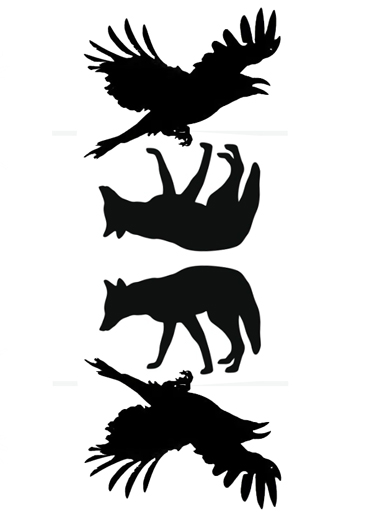Out in the open country—desert, forest, or plain—you’ll sometimes spot a coyote trotting with a black-feathered shadow gliding above or hopping behind. That shadow is usually a raven; believe it or not, those two critters have a working relationship. It’s not friendship or rivalry—more like a loose alliance between two clever survivors who know how to get by in a harsh world.

The raven is sharp as a tack. One of the most intelligent birds out there, it’s always watching, always thinking. It knows that a coyote’s nose is one of the best tools for sniffing out a meal. So it tags along. The coyote does the dirty work—flushing out prey, unearthing carcasses, chasing rabbits—and the raven swoops in for its share once the chase ends. Sometimes it even helps the coyote out, flying ahead and acting excited when it spots something promising. There’s evidence that coyotes pick up on this behavior and follow the raven’s lead. They’ve learned to pay attention.
For the coyote, it’s a pretty good deal, too. It might not be able to see as far as a raven can from the air, but it knows that if a raven’s hanging around, something must be going on. Ravens don’t waste energy for nothing. If they’re diving, croaking, and making a scene, there’s usually food nearby. A clever coyote watches that behavior and follows its feathered guide straight to the prize.

It’s the kind of relationship that’s been going on quietly for generations—no contract, no handshake, just two species reading each other’s cues. It brings to mind those old Native American stories where the coyote and the raven are both tricksters: wily, unpredictable, and always looking for the next angle. In the real world, the desert happens to be their stage.
But let’s not pretend it’s all rosy. These guys are not buddies. They tolerate each other because it works. And when it stops working—say, if food is scarce or one gets too bold—things can get tense. Coyotes will chase ravens off if they feel annoyed or cheated. And on the flip side, ravens are scavengers at heart. If a young coyote meets an unfortunate end, a raven won’t hesitate to peck at the remains. Nature isn’t sentimental.
Furthermore, if a coyote stumbles upon a dead raven, you can bet it’ll at least give it a sniff. Coyotes aren’t picky. They’ll chew on roadkill, fruit, old hamburger wrappers, and yes—if legend (and plenty of firsthand accounts) holds—even an old boot. So a raven carcass? That’s fair game. They might not go out of their way to chase down a healthy raven, but if one’s lying sick, twitching, and eyes rolled back, a coyote will pick through the clump a bit.
Ultimately, the relationship between the coyote and the raven is a perfect example of how survival shapes behavior. These two animals don’t need to like each other—they need to pay attention. It’s all about reading the land, knowing your neighbors, and taking chances when they come. They may come from different worlds—one with wings, the other with paws—but they’ve carved out a quiet understanding. And in the wild, that can mean the difference between a good day and an empty belly.